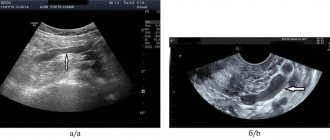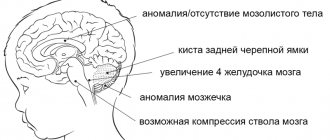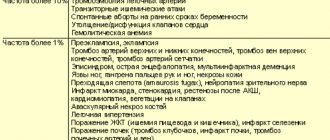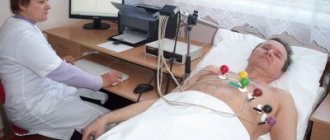Vascular crises (angiodystonic crises) are acute transient disturbances of systemic hemodynamics or local blood flow caused by disorders of vascular tone, i.e. hypertension or hypotension of the arteries, hypotension of the veins, dysfunction of tissue arteriovenous anastomoses (AVA).
Observed in functional and organic pathologies of the central nervous system, endocrine system, hypertension and other diseases characterized by disturbances in the regulation of vascular tone (including due to excessive production of vasoactive substances - adrenaline, bradykinin, histamine, serotonin, etc.), with damage to the vascular wall itself and its receptor apparatus (for example, as a result of frostbite, atherosclerosis, vasculitis).
Changes in the function of vascular smooth muscle membranes and the permeability of their calcium channels are important in the pathogenesis of angiodystonia. Vascular crises are divided into regional and systemic.
What is hypothalamic syndrome?
Hypothalamic syndrome is a symptom complex of damage to the hypothalamic region, characterized by autonomic, endocrine, metabolic and trophic disorders.
Various stressful situations, psychotraumatic effects, intoxication, traumatic brain injuries, vascular diseases, tumors, acute infections (influenza, ARVI (ARI), pneumonia, viral neuroinfections), chronic infections (cholecystitis, sinusitis, tonsillitis) play a significant role in the occurrence of hypothalamic syndrome. , rheumatism, tuberculosis). Increased vascular permeability of the hypothalamus can facilitate the penetration of toxins and viruses from the blood into the brain, and displacement of cerebrospinal fluid during traumatic brain injury can cause hypothalamic dysfunction. The occurrence of hypothalamic syndrome is also facilitated by hereditary and acquired constitutional defects of the hypothalamus and closely related structures of the limbic-reticular complex (limbic system and reticular formation) and the pituitary gland. Often, the pathological course of pregnancy and childbirth can be one of the factors of improper formation and maturation of the hypothalamus at various stages of fetal ontogenesis.
Sympathoadrenal crisis
Sympathoadrenal crisis in hypothalamic syndrome is manifested by severe headache, pain in the heart, palpitations, a feeling of fear, palpitations, a feeling of fear, difficulty breathing, numbness of the extremities. During a crisis, the skin is pale, dry, blood pressure (BP) is elevated, there may be slight hyperthermia (37.0; 37.1; 37.2; 37.3; 37.4; 37.5; 37.6; 37.8 ; 37.9 degrees Celsius), dilated pupils, increased erythrocyte sedimentation rate (reaction) (ESR, ROE), hyperglycemia (increased blood glucose levels). The attack often ends with chills, frequent urination (pollakiuria) or a single copious discharge of urine (polyuria).
Symptoms
A vegetative crisis most often first appears at a certain age - usually 20-30 years. But there have been cases of the disease being diagnosed in children under 15 years of age and elderly people after 65. The main category of people exposed to attacks of vegetative crisis are women. In men, this disease is diagnosed 2-3 times less often than in the fairer sex. During panic attacks, the following clinical picture usually emerges: ⅔ of all symptoms are vegetative, the rest are emotional-affective disorders. Each type of vegetative crisis has its own symptoms, they depend on the severity of the panic disorder and are determined using a special scale.
The following symptoms are characteristic of a sympathoadrenal crisis: disruption of the heart and rapid heartbeat, pain and pulsation in the head, fever, pale skin, chills, an inexplicable feeling of fear. It ends suddenly, with a large amount of urine being released. After this, an asthenic state begins to develop.
Symptoms of a vagoinsular crisis are as follows: a person begins to feel a lack of air, he has a feeling of suffocation, shortness of breath, the pulse becomes rare, the heart works intermittently, the skin becomes hyperemic, pain appears in the stomach, intestinal motility increases, etc.
The mixed type of vegetative crisis combines the characteristics of the species described earlier, i.e. sympathoadrenal and vagoinsular types. The main symptoms of a vegetative crisis of this type are attacks of causeless panic, anxiety or fear, to which are added several manifestations of a particular disease. In this case, human psychosomatics produces such sensations as depersonalization, derealization, fear of uncontrollable actions, loss of reason, and fear of death.
Various reasons can lead to the onset of a vegetative crisis in a person. It can be the result of prolonged stress or neurosis, postpartum trauma, or head trauma. A vegetative crisis can also be caused by disturbances in the functioning of the central nervous system, and conditions such as premenstrual syndrome in women, urolithiasis, puberty, etc. Uncontrolled use of any medications can also provoke this disease.
Neuroendocrine-metabolic form | Hypothalamic syndrome
The neuroendocrine-metabolic form of the hypothalamic syndrome is characterized mainly by endocrine disorders due to loss or increased secretion of hormones of the anterior pituitary gland.
The following diseases may occur.
Diabetes insipidus
1) diabetes insipidus (polyuria, polydipsia, dry mouth, general weakness);
Adiposogenital dystrophy
2) adiposogenital dystrophy - Pechkranz-Babinsky-Fröhlich syndrome (nutritional obesity, increased appetite, hypogenitalism, general weakness, various endocrine disorders);
Frontal hyperostosis
3) frontal hyperostosis - Morgagni-Stewart-Morel syndrome (hyperostosis of the internal plate of the frontal bone, amenorrhea, obesity, virilism);
Juvenile basophilism
4) juvenile basophilism - prepubertal basophilism (obesity, increased blood pressure / arterial hypertension /, stretch marks / stretch marks / on the skin;
Pituitary cachexia
5) pituitary cachexia - hypothalamic-pituitary cachexia, panhypopituitarism, Simmonds syndrome (rapid decrease in body weight by 1.5 - 2 times with the development of cachexia / exhaustion /;
Malignant exophthalmos
6) malignant exophthalmos - exophthalmic ophthalmoplegia (slowly progressive exophthalmos without thyrotoxicosis, at first it can be one-sided, oculomotor disorders, more often external ophthalmoplegia, diplopia, possible keratitis, atrophy of the optic discs);
Precocious puberty
7) premature puberty (pubertas praecox) - more often manifested in girls by the early development of secondary sexual characteristics, often combined with the following symptoms: high growth, bulimia, polydipsia, polyuria, sleep disturbance (insomnia), changes in the emotional-volitional sphere / children become rude, cruel, evil, have a tendency towards vagrancy, theft, antisocial violations/;
Delayed puberty
 delayed puberty – occurs mainly in boys during adolescence and is manifested by female-type obesity, hypogenitalism, lethargy, and decreased initiative;
delayed puberty – occurs mainly in boys during adolescence and is manifested by female-type obesity, hypogenitalism, lethargy, and decreased initiative;
Gigantism
9) gigantism is a disease that is characterized by the presence in adolescents and children of open epiphyseal growth zones with excessive secretion of self-tropic hormone (STH), height in boys and young men reaches more than 200 cm, and in girls and women more than 190 cm;
Acromegaly
10) acromegaly - Marie syndrome, or Marie-Lery syndrome - is a neuroendocrine syndrome caused by a significant increase in the secretion of somatotropic hormone of the anterior pituitary gland; the syndrome was first described in 1886 by P. Marie; and in most cases it is associated with an eosinophilic pituitary adenoma, sometimes acromegaly can develop after traumatic brain injury, intoxication, infection, stressful conditions; there is an increase in the size of the hands, feet, facial skeleton, nose, tongue, ears, and internal organs;
Dwarfism, dwarfism
11) nanism / dwarfism / - (nanos - dwarf) is a clinical syndrome manifested by extremely short stature (compared to the gender and age norm), occurs relatively often, causing mental distress in both the child and his parents, especially against the background acceleration in other children, often manifests itself in combination with other developmental defects (hydrocephalus, microcephaly, mental retardation, eye changes), in patients with chromosomal syndromes (Down disease, where, along with dwarfism, there are multiple developmental anomalies);
Itsenko-Cushing's disease
12) Itsenko-Cushing's disease (pituitary basophilism, Cushing's disease) develops due to excessive release of adrenocorticotropic hormone (ACTH) by the pituitary gland; first described by N. M. Itsenko and H. W. Cushing; occurs more often with basophilic pituitary adenoma, traumatic brain injury, inflammatory diseases of the brain, long-term use of large doses of corticosteroids or ACTH, manifested by symptoms of hypercortisolism (uneven obesity, moon-shaped face, fat deposits in the neck, upper half of the body, skin trophic disorders, osteoporosis , increased blood pressure, amyotrophy in the proximal limbs, intracranial hypertension, pyramidal and brainstem symptoms);
Lawrence-Moon-Bardet-Biedl syndrome
13) Lawrence-Moon-Bardet-Biedl syndrome is a hereditary diencephalic-retinal pathology, which includes Lawrence-Moon syndrome (first described in 1866 by JZ Laurence and R. Ch. Moon) and Bardet-Biedl syndrome (first described by G. Bardet in 1920 and A. Biedl in 1922), the type of inheritance is autosomal recessive and polygenic determination, the main symptoms of Lawrence-Moon syndrome are mental retardation, pigmentary retinopathy, hypogenitalism, spastic paraplegia, Bardet-Biedl syndrome - mental retardation, pigmentary retinopathy, hypogenitalism, obesity, polydactyly.
Impaired thermoregulation, hypothalamic syndrome with impaired thermoregulation
Violation of thermoregulation of hypothalamic origin most often manifests itself in the form of prolonged low-grade fever, against the background of which hyperthermic crises sometimes occur with an increase in body temperature to 38.0 - 38.5 - 39.0 degrees Celsius. Unlike an increase in temperature during infectious diseases (diseases), this hyperthermia has a number of features and differences: an increase in temperature in the morning and a decrease in the evening, its relatively good tolerance, no changes in the blood and urine, a negative amidopyrine test, a perverted thermoregulatory Shcherbak reflex (with normal thermoregulation rectal temperature increases by 0.5 degrees Celsius after immersing hands in water at a temperature of 32 degrees and gradually increasing it to 42 degrees). Violation of thermoregulation can also manifest itself as hypothermia and poor tolerance to drafts, weather changes, and low temperatures.
Regional crises
Regional crises correspond to localized disturbances in the blood supply to an organ or tissue, depending on the type of angiodystonia. Hypertension of the artery (artoriole), sometimes reaching the level of vasospasm, is characterized by tissue ischemia due to a sharp restriction or cessation of blood flow; hypotension of the arteries is expressed by excessive inflow (hyperemia, local increase in temperature; pathological opening of the AVA - tissue ischemia with normal or increased inflow (the phenomenon of shunt "stealing" of capillaries); hypotension of the veins - by their overstretching, local stagnation of blood in the capillaries and pericapillary edema of the tissue.
The most common regional vascular crises in clinical practice include attacks of hemicrania during migraine and other types of so-called vasomotor headaches (see Hemicrania, Migraine neuralgia, Migraine), attacks of digital ischemia during Raynaud's disease and syndrome (see Rebno's disease), erythromelalgia and reducing acrocyanosis in angiotrophoneurosis, the so-called variant angina (caused by spasm of the coronary artery - see Angina), cerebral vascular crises in hypertension (see Hypertensive crises).
Neurotrophic form
The neurotrophic form includes various trophic disorders due to damage to the hypothalamus: trophic ulcers, focal or diffuse edema of different parts of the body (especially in combination with vegetative-vascular crises), brittle nails, osteoporosis, osteodystrophy, some types of alopecia /hair loss/. In its pure form, the neurotrophic form is rare, and trophic disorders are included in the structure of other forms of hypothalamic syndrome, more often in the neuroendocrine-metabolic form.
Diagnostic methods
Determining the presence of a vegetative crisis is quite difficult even for an experienced specialist. To confirm the diagnosis, a comprehensive diagnosis is necessary, which includes a medical examination, assessment of reflex functions, ECG, pulse check, blood pressure, etc. Only after receiving the results can we make assumptions about the presence of a vegetative crisis in the patient. The disease can be accurately diagnosed only when the attack is over by excluding the following ailments and conditions:
- cardiac dysfunction - requires 24-hour cardiac monitoring, stress ECG, and cardiac ultrasound;
- stroke, brain tumors - CT and MRI are required;
- vascular crisis - encephalography and CT are performed;
- bronchial asthma – it is necessary to carry out breathing tests and skin tests to determine allergies;
- internal blood loss - you need an ultrasound of the peritoneal and pelvic organs;
- hypertensive vegetative crisis - CT or MRI is performed;
- mental disorders - examined by a psychiatrist.
When all of the listed pathologies are excluded and it is determined that the peak of the crisis occurs 10 minutes after the onset, and in addition an anxious feeling or deep-seated fear appears, the patient is diagnosed with a vegetative-vascular crisis.
In some cases, a similar diagnosis is given to children. The cause of this phenomenon may be psychological trauma or stress. As a rule, the development of a vegetative crisis in childhood is caused by quarrels in the family.
Neuromuscular form, catalepsy, narcolepsy | Hypothalamic syndrome
The neuromuscular form is manifested by general weakness, adynamia, and transient atypical attacks of catalepsy. Catalepsy (affective adynamia, emotional asthenia, affective loss of muscle tone, Levenfeld-Enneberg syndrome) is a short-term, paroxysmal loss of muscle tone, which occurs more often with strong emotional influences and leads to the patient falling without loss of consciousness. Catalepsy is a symptom of narcolepsy. Narcolepsy (Gelino's disease) is a disease from the group of hypersomnias, characterized by attacks of irresistible drowsiness and falling asleep during the daytime. Neurologists and neuropathologists distinguish essential narcolepsy, which occurs without visible external influences, and symptomatic narcolepsy, which occurs after infections, epidemic encephalitis, traumatic brain injuries, tumors of the 3rd ventricle, pituitary gland, internal hydrocephalus. Attacks of drowsiness occur suddenly, often in inappropriate conditions: while eating, walking, talking, urinating. The attacks usually last for several minutes. Depending on the external manifestations, neurologists distinguish 2 forms of narcolepsy: monosymptomatic, which is manifested only by attacks of falling asleep, and polysymptomatic, which is manifested by attacks of falling asleep, catalepsy, night sleep disturbances, and hypnogogic hallucinations.
Hallucinations, Pickwissky syndrome, Kleine–Lewin syndrome
Hallucinations are false perceptions without a real object. Neuropathologists , neuropsychiatrists and psychiatrists distinguish between visual, auditory, olfactory, gustatory, tactile, and general senses. Hallucinations that occur while falling asleep are called hypnagogic. Hallucinations that occur upon awakening are called hypnopompic hallucinations. Movement disorders in the neuromuscular form of hypothalamic origin, they do not have a clear clinical picture and delineation, they are very variable, unstable, fragmented, and prone to paroxysmal progression. This same form includes some forms of phenocopies of neuromuscular diseases. Disturbances in sleep and wakefulness can be manifested by changes in the sleep formula (drowsiness during the day and insomnia at night), hypersomnia, narcolepsy, periodic hibernation syndrome, which is characterized by sleep attacks lasting from several hours to several weeks. At this time, muscle hypotonia, areflexia, arterial hypotension, and lack of control over the activity of the pelvic organs occur. More complex syndromes of sleep and wakefulness disorders may also be observed: Pickwickian syndrome , Kleine–Lewin syndrome. Pickwickian syndrome is a pathological condition of obesity in small people, manifested by shallow breathing, arterial hypertension (increased blood pressure), shortness of breath, drowsiness and general weakness. Kleine–Lewin syndrome is characterized by attacks of sleepiness with bulimia.
Clinical forms of hypothalamic syndrome rarely occur in isolated form. Thus, vegetative-vascular (vegetative-vascular) crises can be observed in neuroses, diseases of internal organs, vegetative-vascular dystonia (vegetative-vascular dystonia). Neuroendocrine metabolic disorders occur in other pathological processes of non-hypothalamic localization, as well as in primary endocrine diseases.
Causes of vegetative-vascular crises
The causes of crises during VSD are determined by the peculiarities of the cardiovascular system, as well as various vascular and nervous pathologies observed at different ages. Among the most common reasons it is worth highlighting:
- Autonomic dysfunctions in children.
- Uneven growth of internal organs and the formation of the hormonal system during puberty.
- The presence of chronic depression and stress.
- Spinal diseases.
- Endocrine diseases.
- Disturbances in the functioning of the gastrointestinal tract.
- Hormonal changes in the body during menopause.
How to treat hypothalamic syndrome, how to get rid of hypothalamic syndrome!
Comprehensive differentiated treatment of patients with hypothalamic syndrome with the widespread use of effective techniques allows one to achieve good results even with severe symptoms.
At the first consultation, the doctor will tell you about the main factors and symptoms of the disease: what is hypothalamic syndrome in newborns, children, adolescents, adults (men and women), what is mild, moderate, severe hypothalamic pubertal juvenile neuroendocrine syndrome (neuroendocrine form) How the army, Wikipedia and obesity are related to hypothalamic syndrome.
Sign up for a consultation. There are contraindications. Specialist consultation is required. Photo: Dgm007 | Dreamstime.com\Dreamstock.ru. The people depicted in the photo are models, do not suffer from the diseases described and/or all similarities are excluded.
Related posts:
Hypothalamic syndrome, treatment of hypothalamic syndrome, how to treat
Occipital neuralgia: symptoms, treatment in Saratov
Facial nerve, facial nerve neuritis, treatment, inflammation, paresis, neuritis, neuropathy, facial nerve neuralgia
Vegetative vascular dystonia: treatment of VSD, how to treat VSD, symptoms, signs
Insomnia, treatment of insomnia in Saratov, what to do for insomnia
Comments ()
How to treat manifestations of a vegetative crisis
To treat a vegetative crisis, an integrated approach is used, which includes not only medications. In accordance with the patient’s complaints, the doctor determines the duration of the attacks, the severity of the symptoms, and only then prescribes medications. In addition, the patient must learn to overcome attacks independently.
Drug treatment
For this disease, symptomatic therapy is prescribed. To stop an attack, the following may be prescribed:
- for cardiac dysfunction - Valocordin, Corvalol or Anaprilina;
- to eliminate anxiety - Relanium or Clonozepam;
- A course of treatment with antidepressants under medical supervision is also prescribed.
In addition, it will be necessary to treat somatic pathologies and abnormalities in the functions of the central nervous system identified during the diagnosis. The same actions can be used to stop an attack of vegetative crisis.
Non-drug treatment
A person diagnosed with a vegetative crisis must learn to identify the symptoms of an approaching attack and overcome it on his own. Breathing exercises are suitable to eliminate the problem. With proper and slow breathing, a large amount of oxygen enters the body, which helps reduce the severity of symptoms that appear during an attack. The supply of carbon dioxide to the body is also effective. For this purpose, you can use a paper bag to exhale and inhale into it.
If there is a suspicion that an attack has begun, the patient is advised to change the environment. To do this, you need to leave the room or transport, try to pay attention to the surrounding nature to distract your thoughts.










